Table of Contents
NCERT Solutions for Science Chapter 8 NCERT Solutions for Science Chapter 8
INFINITY LEARN’s NCERT Solutions for Class 8 Science Chapter 8 are written by subject experts to help students comprehend the subjects covered in the chapter. The revision notes included in this work can be used by students. Students will use the solved problems to prepare for their exams on the chapter. Students may learn and comprehend the subject properly with the NCERT Solutions for Chapter 8 Class 8 Science “Cell structure and function.” Additionally, they may get these NCERT Solutions for free from INFINITY LEARN.
NCERT Solutions for Science Chapter 8 Cell structure and functions will be a helpful resource for you in swiftly reviewing the chapter and gaining clarity before the exams. Remember to do it on a daily basis. These NCERT solutions can help you improve your speed while writing responses to problems and increase your test confidence.
To prepare for their upcoming exams, students can also obtain NCERT Solution PDF for all courses. Students who are looking for better solutions can download Class 8 Maths NCERT Solutions to assist them in revising the entire syllabus and scoring higher marks in their exams.
CHAPTER 8 _CELL – STRUCTURE AND FUNCTIONS NCERT SOLUTIONS
1.Indicate whether the following statements are True (T) or False (F).
a) Unicellular organisms have one-celled body. ( T )
b) Muscle cells are branched. ( F )
c) The basic living unit of an organism is an organ. ( F )
d) Amoeba has irregular shape. ( T )
2.Make a sketch of the human nerve cell. What function do nerve cells perform ?
A.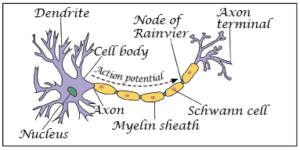
Nerve cells transmit messages to the brain and also take away the messages from the brain to the receptor organs. Thus, they control the working of different parts of the body.
3.Write short notes on the following.
A. a) Cytoplasm b) Nucleus of a cell
a) Cytoplasm :
i) It is a fluid that fills the cell and is present between the plasma membrane and the nucleus.
ii) Cell organelles such as mitochondria, ribosomes, golgi bodies etc. are suspended in the cytoplasm.
iii) The cytoplasm helps in the exchange of materials between cell organelles.
b) Nucleus of a cell : The nucleus is a spherical structure generally present at the centre of a cell. The nucleus is composed of nuclear membrane, nucleolus and chromosomes.
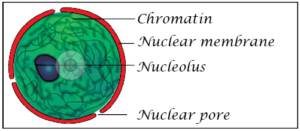
i) Nuclear membrane is a double-layered membrane which separates the contents of the nucleus from the cytoplasm.
ii) Nucleolus is a small spherical body that is not bound by any membrane.
iii) Chromosomes are thread-like structures that carry genes. Genes contain information necessary for the transfer of characteristics from the parents to the offspring.
4. Which part of the cell contains organelles?
A. Cytoplasm is the part of the cell that contains various organelles such as mitochondria, ribosomes, golgi bodies etc.
5.Make sketches of animal and plant cells. State three differences between them.
A.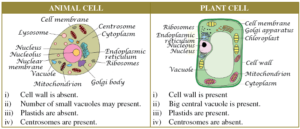
6.State the differences between eukaryotic and prokaryotic cells.
A.
| WILDLIFE SANCTUARY | BIOSPHERE RESERVE |
| i) These are well developed cells. | i) These are most primitive cells. |
| ii) They have distinct nucleus.
Eg : Chambal wildlife sanctuary, Gharial wildlife sanctuary etc. |
ii) They have primitive (not well organised) nucleus.
Eg : Pachmarhi biosphere reserve
|
| iii) Membrane bound cell structures (organelles) are present. | iii) Membrane bound cell structures (organelles) are absent. |
| iv) DNA is present in the nucleus. | iv) DNA is present in the cytoplasm. |
| v) Chromatin is present inside the nucleus. | v) A long, highly coiled circular DNA is present in the cytoplasm. |
| vi) Structure of the cell can be studied under light microscope.
Eg : Cells of algae, fungi and cells of higher plants and animals. |
vi) Structure of the cell can be studied under an electron microscope.
Eg : Bacterial cell. |
7. Where are chromosomes found in a cell ? State their function.
A. i) Chromosomes are present within the nucleus of a cell.
ii) Chromosomes play an important role in the inheritance of the characters.
iii) They carry genes that help in the inheritance or transfer of characters from the parent to the offspring.
8. ‘Cells are the basic structural units of living organisms’. Explain.
A. i) Cells are the building blocks of life. They assemble to make the body of every organism.
ii) Hence, cells are referred as ‘the basic structural units of living organisms’.
9. Explain why chloroplasts are found only in plant cells.
A. i) Chloroplasts contain a green coloured pigment – chlorophyll. It helps in the trapping of solar energy
ii) This helps the plants to synthesise their own food.
iii) Hence, chloroplasts are present only in plants.
NCERT Solutions for Class 8 Science
10.Complete the crossword with the help of clues given below.
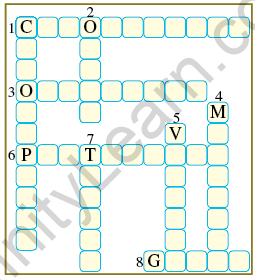
Across :
This is necessary for photosynthesis.
Term for component present in the cytoplasm.
The living substance in the cell.
Units of inheritance present on the chromosomes.
Down :
Green plastids.
Formed by collection of tissues.
It separates the contents of the cell from the surrounding medium.
Empty structure in the cytoplasm.
A group of cells.
A.
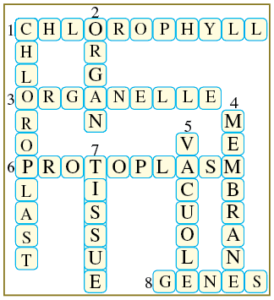
NCERT Solutions for Class 8 Science Chapter 8 – Cell Structure and Functions
The NCERT Solutions Cell structure and function Class 8 PDF can be easily downloaded from INFINITY LEARN’s official website and mobile app. Our team of specialists has organized the NCERT Solutions for Class 8 Science Chapter 8 Cell Structure and Functions to assist students with their school projects and exam preparation. Our NCERT Solutions are provided in a chapter-by-chapter format for all topics. Cell Structure and Functions, Chapter 8 of Class 8 Science, is an important topic because it provides the foundation for all organic studies. Students will be able to master the subject thoroughly by referring to the NCERT Solutions Class 8 Science Chapter 8.
Chapter 8 – Cell Structure and Functions NCERT Solutions for Class 8 Science Chapters
Cell Structure and Functions in NCERT Science Class 8 is a fascinating topic. You will gain a thorough understanding of numerous sections of a cell, such as a nucleus, cytoplasm, and organelles, after reviewing solutions for Class 8 Science Chapter 8. You’ll also learn how to distinguish between eukaryotes and prokaryotes. The ideas of chromosomes, cell form and function, sections of the cell, plant, and animal cells are all covered in this chapter. NCERT Solutions Class 8 Science Chapter 8 will assist students in gaining a firm grasp of these subjects. These NCERT Solutions are available in PDF format for free download.
Chapter-by-Chapter Weightage in Science in Class 8
This Class 8th Science Chapter 8 has a 20-point weighting and is one of the most essential topics taught in the Class 8 Science syllabus. The solutions are based on the most recent CBSE rules, and students may grasp the exam’s question structure by reading NCERT Solutions Class 8 Science Chapter 8.
More information on Chapter 8 Cell Structure and Functions Class 8 may be found here.
8.1 Explain the nucleus of the cell in detail. (1 long)
8.2 Difference between prokaryotes and eukaryotes (1 short)
8.3 What is cytoplasm? (2 short)
8.4 Cells are basic structural units of a living organism (1short, 1 long)
8.5 Explain why chloroplasts are found only in plant cells. (1 short)
Why are NCERT Solutions for Science Chapter 4 in Class 8 so important?
- For pupils’ better understanding, our professionals have made it as simple as feasible.
- Our responses concentrate on the essentials in order to assist students in grasping the core principles.
- It covers all of the chapter’s major subjects, assisting pupils in improving their grades.
- It aids in the development of students’ self-esteem.
- All solutions are offered by subject matter experts, making learning simple.
- NCERT solutions include complete chapter answers as well as some fun activities.
- You will gain a general understanding of the chapter by reading this.
FAQs on NCERT Class 8 Science Chapter 8 Cell – Structure and Functions
What is NCERT Class 8 Science Chapter 8 about?
NCERT Class 8 Science Chapter 8 covers the topic of Cell – Structure and Functions. It explores the fundamental unit of life, the cell, its structure, and various functions.
What are the key concepts covered in this chapter?
This chapter delves into topics such as cell structure, types of cells, cell organelles, functions of different parts of a cell, and the comparison of plant and animal cells.
Why is learning about cell structure important?
Understanding cell structure is essential as cells are the building blocks of life. It forms the basis for comprehending various biological processes.
How do NCERT Solutions benefit students studying this chapter?
NCERT Solutions provide detailed explanations, diagrams, and answers to questions, making it easier for students to grasp cell structure and its functions.
Are cell functions the same in all types of cells?
While certain functions are common, cells can have specialized functions depending on their type, such as nerve cells, muscle cells, and plant cells.
What's the significance of comparing plant and animal cells?
Comparing plant and animal cells helps students understand the differences in structure and functions, contributing to a broader understanding of cell biology.
How can NCERT Class 8 Science Chapter 8 help beyond academics?
Learning about cells and their functions enhances students' awareness of living organisms and the intricacies of life processes.
Where can I find NCERT Class 8 Science Chapter 8 resources?
NCERT Class 8 Science Chapter 8 resources, including textbooks and study materials, are available in schools, libraries, and online educational platforms like Infinity Learn.





